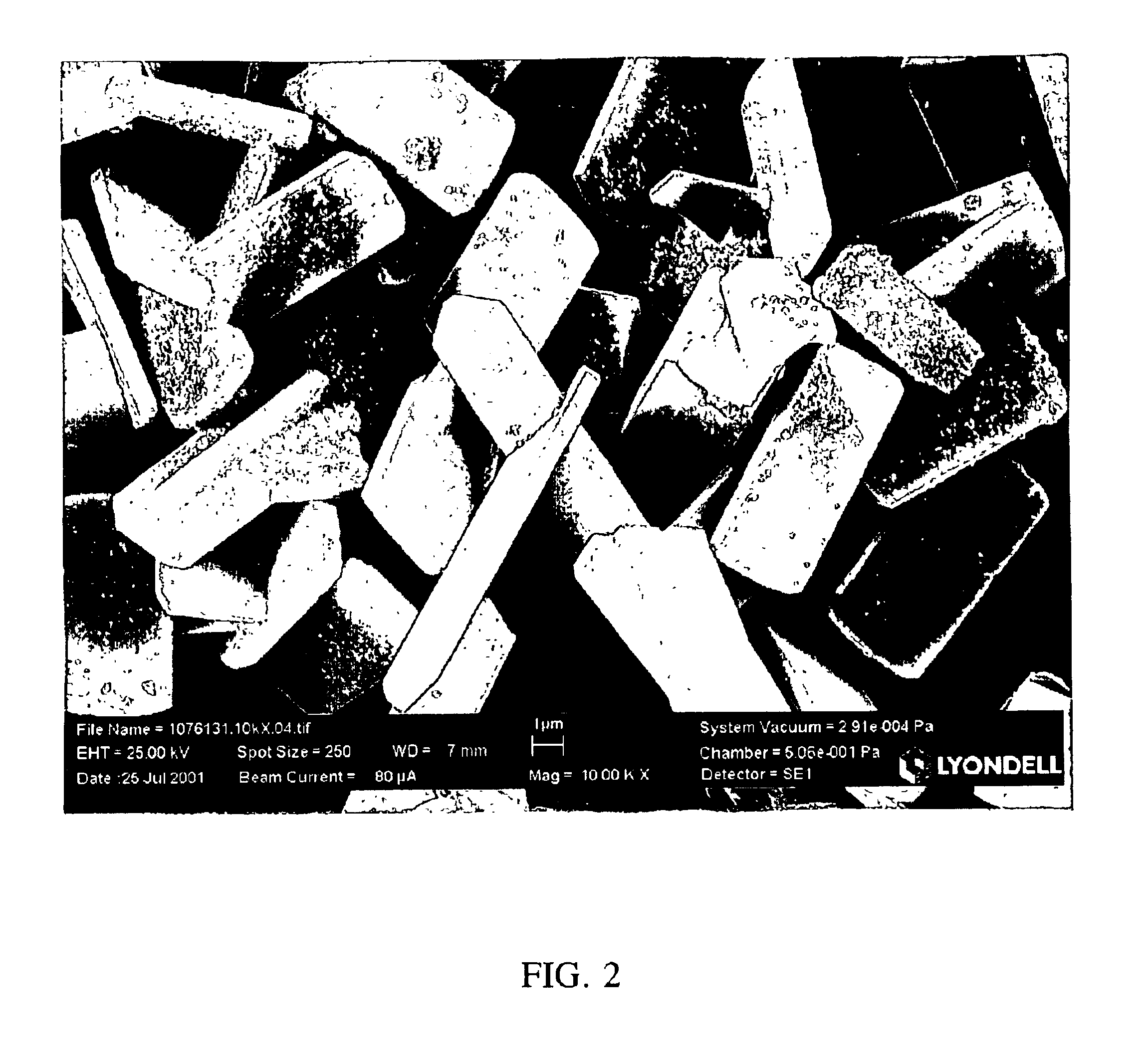Process for direct oxidation of propylene to propylene oxide and large particle size titanium silicalite catalysts for use therein
a technology of titanium silicalite and propylene oxide, which is applied in the direction of physical/chemical process catalysts, organic chemistry, molecular-sieve compounds, etc., can solve the problems of low value of coproducts at times, titanium silicalite is useful in such processes, and the yield of olefin oxide is relatively low, so as to achieve less addition of new catalysts
- Summary
- Abstract
- Description
- Claims
- Application Information
AI Technical Summary
Benefits of technology
Problems solved by technology
Method used
Image
Examples
example 1
Titanium Silicalite Large Crystal Synthesis, Method 1
[0040]To a 3-neck flask is charged 51.06 g distilled water which is then cooled with agitation to 5° C. by means of an ice / water bath. A nitrogen blanket is established with an N2 feed rate of 150 cm3 / m. To the cooled water, 4.4955 g titanium (IV) isopropoxide (98%, Strem 93-2216) is added, with vigorous stirring, following which 9.102 g 30% hydrogen peroxide is added to the flask over 15 min with very vigorous stirring. The flask is stirred for an additional 10 minutes at 5° C. The color of the solution turns yellow upon addition of the hydrogen peroxide, then gold and finally orange. To 254.237 μm of aqueous ammonia is added 45.763 g deionized water to form a 25 wt. % aqueous ammonia solution. The flask is removed from the ice bath, and 250.88 g of the 25% aqueous ammonia is added with continuous stirring. The solution becomes pale green with some white precipitate. The contents are stirred for 10 minutes, then heated to 80° C. ...
examples 8-10
[0049]A variety of titanium silicalite catalysts were prepared from a silica source having a low sodium content. Fumed silica (Aerosil® 380, Degussa) was employed as the silica source. In addition to low sodium content, lower iron and aluminum content is present as compared to the Ludox® AS40 colloidal silica employed in the examples of Tables 1 and 2. The sodium content of Aerosil® 380 is less than 50 ppm as compared to 1300 ppm of the colloidal silica. Trials of a variety of titanium silicalites prepared using a low sodium silica source are compared with a conventional small size titanium silicalite catalyst of the prior art, and subject invention large size titanium silicalite catalysts prepared from a “high” sodium silica source. The relevant physical and chemical properties and catalytic activity are presented in Table 3 below.
[0050]
TABLE 3Large Crystal TS-1 Synthesis and Epoxidation CatalystsCatalystC14578910SiO2 sourceLowLow NaLow NaNaTheo. Ti (wt %)NA1.381.38 4.044.043.032.0...
example 11
[0053]An intergrown crystalline titanium silicalite (TS-1) catalyst was prepared by mixing together 6.8 g of a diethoxysilane-ethyltitanate copolymer (PSITI-109, Gelest, Inc.) containing 19.4 wt % Si and 2.2 wt % Ti, with 10 g of 40 wt % aqueous tetrapropylammonium hydroxide (Alfa) and 25 g water. The mixture was stirred and heated to 80° C. to remove ethanol by distillation. The volume was reconstituted with additional water and the mixture was introduced into a shaker bomb (autoclave) heated at 150° C. for 7 days. The solid product, 2.2 g of a white powder, was analyzed and found to contain 37 wt % Si, 1.1 wt % Ti, 9.2 wt % C and 0.99 wt % N. The x-ray diffraction pattern was consistent with pure titanium silicalite (TS-1). Scanning electron microscopy of the product indicated that relatively large (ca. 6-7 micron) crystalline agglomerates were produced, consisting of highly intergrown crystals.
PUM
| Property | Measurement | Unit |
|---|---|---|
| mean particle size | aaaaa | aaaaa |
| mean diameter | aaaaa | aaaaa |
| mean particle size | aaaaa | aaaaa |
Abstract
Description
Claims
Application Information
 Login to View More
Login to View More - R&D
- Intellectual Property
- Life Sciences
- Materials
- Tech Scout
- Unparalleled Data Quality
- Higher Quality Content
- 60% Fewer Hallucinations
Browse by: Latest US Patents, China's latest patents, Technical Efficacy Thesaurus, Application Domain, Technology Topic, Popular Technical Reports.
© 2025 PatSnap. All rights reserved.Legal|Privacy policy|Modern Slavery Act Transparency Statement|Sitemap|About US| Contact US: help@patsnap.com


